Savings and Consumption in the Post-Pandemic Economy
23 July 2021
Blog
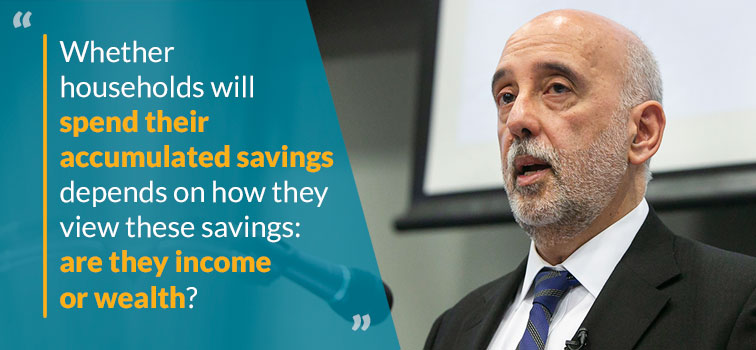
I first wrote about changes in consumption and savings behaviour in Ireland at the onset of the pandemic last year. I asked what consumers might do with their built-up
savings and what the macroeconomic implications of this might be. A couple of weeks ago, I touched on this topic from the Irish perspective. Today, I want to
look at it from an international perspective and take stock of the new evidence that has emerged in the past year.
In 2020, savings and saving rates (i.e., the share of income that is saved) rose sharply across many countries as consumption fell in the face of pandemic-related restrictions and governments provided unprecedented levels of income support. In the euro
area, the increase in savings reflected the fall in spending as disposable income remained broadly unchanged; in Ireland, disposable income grew at the same time as consumption declined. A number of factors have contributed to this, including precautionary
saving (due to uncertainty about the future) and forced saving (due to lack of ability to spend). Consumption increased across countries in the latter half of 2020 as economies partially reopened (see Figure 1). Toward the end of the 2020, savings
rates increased once more in some countries due to public health developments. In 2021, economies are being re-opened in several countries, albeit gradually. Evidence for Ireland suggests (PDF 419.44KB) that consumption has been rising since
the middle of April 2021 as the economy reopened.
Figure 1. Savings Rates
 Sources:
Eurostat, Bureau of Economic Analysis, Australian Bureau of Statistics, Reserve Bank of New Zealand, Office for National Statistics, Statistics Canada.
Sources:
Eurostat, Bureau of Economic Analysis, Australian Bureau of Statistics, Reserve Bank of New Zealand, Office for National Statistics, Statistics Canada.
Looking at the euro area as a whole, data from the sectoral accounts can provide an insight into how households have used these savings. These accounts describe how savings and financial liabilities such as loans can be used to make investments (which
can be financial, e.g., in deposits or pension funds, or can be non-financial, e.g., house purchases). In 2020, the sharp increase in saving by the household sector corresponds with an increase in financial investment (See Figure 2). Non-financial
investment flows were little changed. The majority of the increase in financial investment has been in the form of deposits, although there was also an increase in flows into equity and investment fund shares (see Figure 3). In other countries, such
as the UK and US, pandemic-induced savings also led to large increases in bank deposits.
Figure 2. Household Financing and Investment Flows in the Euro Area
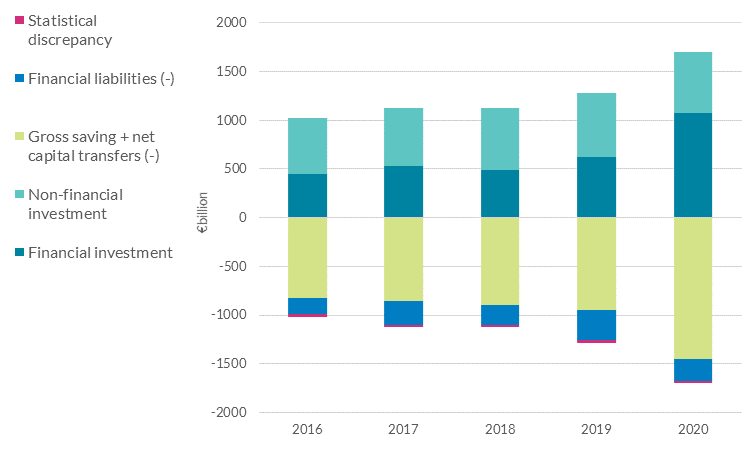
Note: 4-quarter sums of flows.
Source: Eurostat, Quarterly Sector Accounts.
Figure 3. The Breakdown of Financial Investment by the Household Sector in the Euro Area
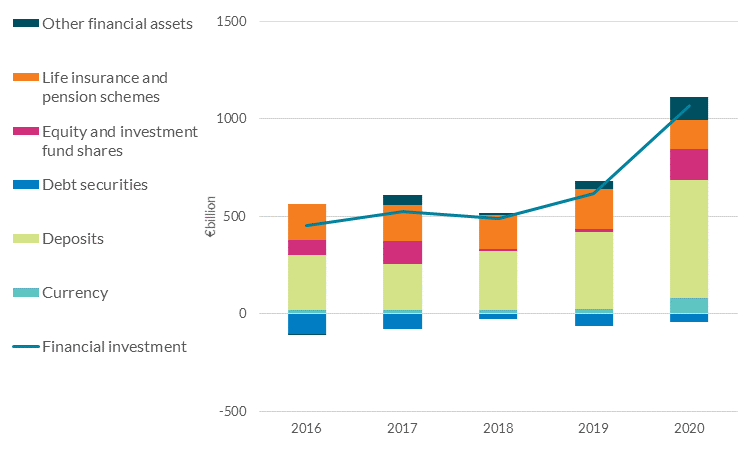
Note: 4-quarter sums of flows.
Source: Eurostat, Quarterly Sector Accounts.
In the first quarter of 2021, financial
investment by euro area households increased at an annual rate of 4.8% (up from 4.1% in the previous quarter), driven mostly by shares and other equity. The annual growth rate of non-financial investment (mainly housing) was 6.5% (0.2% in the last
quarter of 2020).
What is the outlook for savings behaviour after the pandemic?
As vaccination programmes accelerate and consumer confidence increases, it is likely that savings rates will decline which will provide a boost to consumption growth over the next few years. One question that remains to be answered is how quickly the
savings rates will return to pre-pandemic levels. For Ireland, the baseline scenario of the latest Quarterly Bulletin forecast assumes
that the savings rate will decline over the projection horizon and fall below the pre-pandemic level during 2023. For the euro area, the savings rate is assumed to return to its pre-pandemic level during 2022. Overall, it is likely that the share of spending of future income
will return to the previous trend over the coming years.
What will happen to the stock of savings?
We must also consider what will happen to the stock of savings that many people accumulated over the course of the pandemic. The baseline scenario from the latest Quarterly Bulletin assumes a small degree of reduction in the stock of savings in Ireland,
based on the savings rate moving below its 2019 level in 2023. Similarly, for the euro area, only a modest decline in the accumulated stock of savings is assumed in the baseline macroeconomic projections.
To give a sense of the size of accumulated savings, one measure is the stock of excess bank deposits (i.e., in excess of the level that is likely to have prevailed without the pandemic). In the euro area, this is estimated to be €379bn as of May
2021, equivalent to nearly 6% of nominal private consumption in 2019. To consider how this sum might feed into consumption, we can turn to the extensive economics literature on the marginal propensity to consume (MPC). As I outlined a couple of weeks
ago, the MPC is the share of new disposable income or wealth that is consumed by households. For example, if an individual receives an increase of €100 in disposable income and spends €15, her marginal propensity to consume is 0.15.
There is considerable evidence that consumers' MPC out of wealth is much lower than out of income. Given an additional euro of financial wealth, consumers would typically spend between 1 and 7 cents compared to between 20 and 45 cents for income (PDF 594.92KB). Whether households will spend their accumulated savings therefore depends on how they view these savings: are they income or wealth? The fact that a large
share of the stock of savings is held as relatively liquid bank deposits weighs in favour of viewing the savings as more akin to income. However, as savings are held for increasingly long periods and the need for liquidity diminishes, households may
increasingly view their savings as wealth. It is likely that the MPC for excess savings during the pandemic will be somewhere between the values for financial wealth and income.
The distribution of accumulated savings also matters for the evolution of any rundown of those savings. Savings in the pandemic tended to be accumulated by older, wealthier households. These households were more likely to maintain their incomes throughout the pandemic. Their consumption was also more constrained by the closure of the non-essential services on which they spend a greater share of their income. Taken together, this could potentially create the conditions for a boost to consumption from pent-up
demand. However, there is a large body of evidence which shows that wealthier people and older people spend less of any additional income or wealth (see recent research from the Central Bank of Ireland (PDF 563.14KB) and the ECB (PDF 1.64MB), as well as two papers from 2017 and 2015).
If these effects held, there would be a dampening effect on any consumption increase.
In thinking about the outlook for consumption, we have to consider the types of goods or services for which there might be pent-up demand. Recent research shows that the outlook for recovery from a demand-driven recession depends on whether expenditure cuts during a recession were concentrated in services or durable goods. The recovery is likely to be weaker if the cuts were mostly in services, i.e.,
the kind of items wealthier people were restricted from buying during the pandemic, as potential for pent-up demand is weaker: there is a limit to how much dining out, for example, you can catch-up on.
In contrast, the research shows that pent-up demand for durable goods leads to a recovery that exceeds the previous trend. The purchase of a new durable good, such as a washing machine, can take place after restrictions ease (so consumption is deferred
rather than lost). Recent evidence from the US and euro area supports this: US real Personal Consumption Expenditure remained below pre-pandemic levels for services as of May 2021 while it has recovered for goods, especially for durables (see Figure
4). Similarly, in the euro area in 2020 Q3 and Q4, when restrictions were relaxed, demand for durables was above the pre-pandemic trend while service consumption remained well below the pre-pandemic level.
Figure 4. Consumption expenditure of the United States and euro area
Panel A: United States
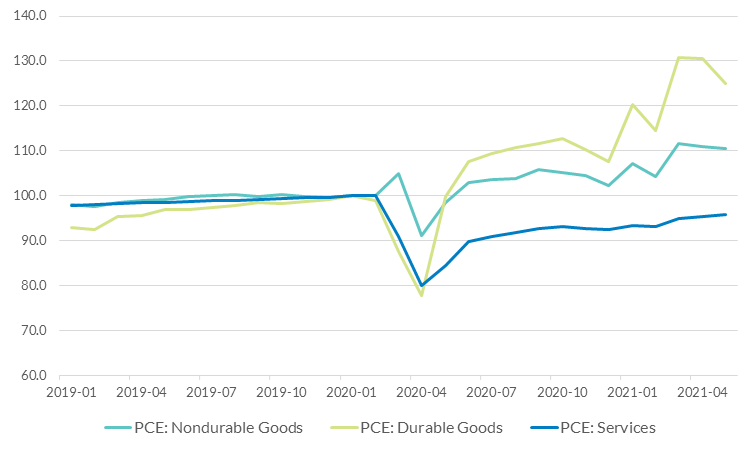
Panel B: Euro Area
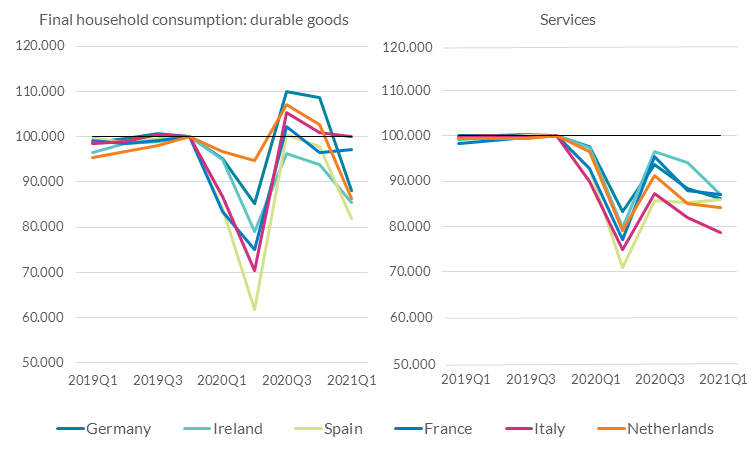
Note: 2019Q4=100. Services for Spain also includes non-durable and semi-durable goods.
Source: FRED, Eurostat.
Consumption and inflation dynamics
A reversion of the savings rate to more normal levels, over the next year to two years, will stimulate consumption and support recovery. This would be further bolstered by some unwinding of the stock of accumulated savings. Consumption growth may also
place upward pressure on prices of consumer goods and services, particularly if there are demand and supply mismatches in some sectors, arising from the pandemic. However, these supply constraints would likely be resolved over the medium term, meaning
the related inflationary pressures would be temporary. In any case, the Governing Council of the ECB is well equipped with the tools to address sustained upward price pressures.
Gabriel Makhlouf
Read more: